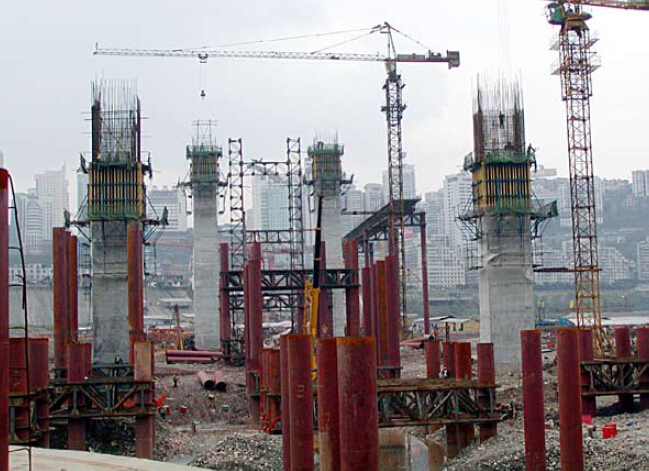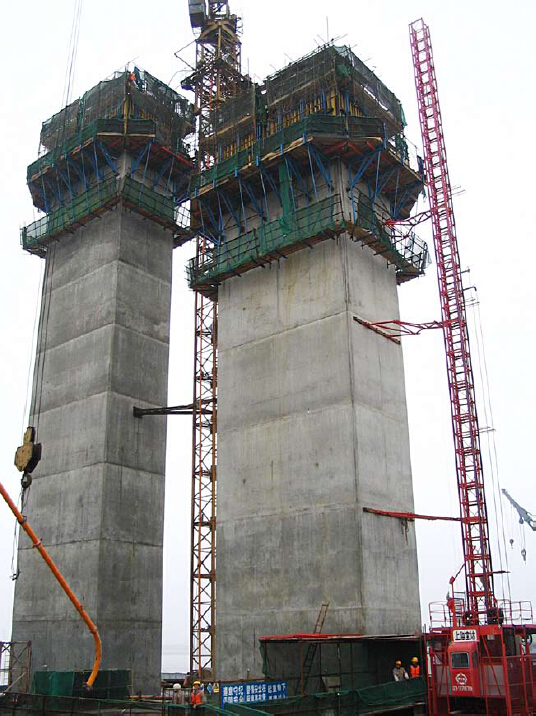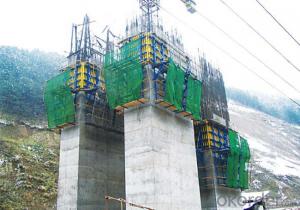Climbing Bracket CB-210 for formwork and scaffolding system
- Loading Port:
- Tianjin
- Payment Terms:
- TT OR LC
- Min Order Qty:
- 50 m²
- Supply Capability:
- 1000 m²/month
OKorder Service Pledge
OKorder Financial Service
You Might Also Like
Climbing Bracket CB240 & CB210
They are framework brackets for supporting large-area wall formwork.
Typical applications for the CB240&CB210 are pier and column/shear wall/core walll/ in the
building.
CB210 has smaller size than CB240, it will be cost effective in some condition.
Characteristics:
◆ High bearing capacity
The high loading capacity of the brackets allow very large scaffold units. This saves the number
anchor points required as well as reducing climbing times.
◆ Simple moving procedure by crane
Through the strong connection of formwork together with the climbing scaffold, both can be moved
as a single climbing unit by crane. Thus valuable time-savings can be achieved.
◆ Fast striking process without a crane
With the retrusive set, large formwork elements can also be retracted quickly and a minimum of
effort.
◆ Safe with work platform
The platforms have assembled firmly with bracket and will be climbing together, without scaffolding
but can work safely in spite of your high location.


- Q:Can steel formwork be used for both horizontal and vertical concrete placement?
- Both horizontal and vertical concrete placement can utilize steel formwork. Steel formwork is a versatile and long-lasting solution for creating molds or frames that maintain wet concrete in the desired shape until it sets and hardens. This kind of formwork is frequently employed in construction projects for various purposes, including horizontal and vertical concrete placement. Steel forms possess enough strength to withstand the weight and pressure of the concrete, which renders them suitable for vertical applications like walls, columns, and beams. Moreover, steel formwork can be easily adjusted or modified to accommodate different shapes and sizes, making it perfect for horizontal placements such as slabs, floors, and pavement. In general, steel formwork offers flexibility, strength, and stability, making it suitable for a wide range of concrete placement requirements.
- Q:What are the common accessories used with steel formwork?
- Some common accessories used with steel formwork include form ties, wedges, form release agents, formwork clamps, and form liners. Form ties are used to hold the formwork together and ensure that it remains in place during concrete pouring and curing. They are typically made of steel and are available in various lengths and designs to suit different formwork requirements. Wedges are used in conjunction with form ties to secure the formwork tightly. They are typically made of steel or plastic and are inserted into the form tie to secure it firmly. Form release agents are applied to the formwork surface to prevent the concrete from sticking to the formwork. They create a barrier between the concrete and the formwork, making it easier to remove the formwork after the concrete has cured. Formwork clamps are used to hold the formwork panels together and ensure that they remain aligned and in place during concrete pouring. They are typically made of steel and come in various sizes and designs to suit different formwork systems. Form liners are used to create decorative patterns or textures on the surface of the concrete. They are typically made of plastic or elastomeric materials and are attached to the formwork before concrete pouring. Once the concrete has cured, the form liners are removed, leaving behind the desired pattern or texture on the concrete surface. These accessories are commonly used with steel formwork systems to enhance the efficiency and effectiveness of the formwork process and ensure high-quality concrete construction.
- Q:What are the typical lead times for manufacturing and delivering steel formwork?
- The typical lead times for manufacturing and delivering steel formwork can vary depending on various factors. Generally, lead times can range from a few weeks to a few months. The manufacturing lead time for steel formwork typically depends on the complexity of the design, the quantity required, and the capacity of the manufacturer. If the design is straightforward and the manufacturer has available capacity, the lead time can be relatively shorter, around 2-4 weeks. However, if the design is more intricate or if the manufacturer is facing high demand or limited capacity, the lead time can extend to 6-8 weeks or even longer. Once the steel formwork is manufactured, the delivery lead time will depend on the distance between the manufacturing facility and the project site, as well as the mode of transportation chosen. Local or regional deliveries can generally be completed within a few days to a week, whereas international shipments may take longer due to customs clearance and additional logistics involved. It is important to consider these factors when estimating the overall lead time for steel formwork delivery. It is worth noting that these lead times are just general estimates, and actual lead times can vary significantly depending on the specific circumstances. Therefore, it is recommended to consult with the manufacturer or supplier directly to get accurate lead time information for a particular steel formwork project.
- Q:How does steel formwork handle different concrete expansion properties?
- Steel formwork is a highly durable and rigid material that can easily handle different concrete expansion properties. Its strength and stiffness allow it to withstand the pressure exerted by expanding concrete without deforming or cracking. Additionally, steel formwork is typically designed with expansion joints or gaps, which provide sufficient space for the concrete to expand and contract without causing any structural issues. This ensures that the formwork remains intact and maintains its shape, allowing for successful concrete pouring and curing.
- Q:What are the different accessories and attachments available for steel formwork?
- There are several accessories and attachments available for steel formwork, including form ties, formwork clamps, formwork braces, formwork connectors, formwork wedges, formwork pins, formwork screws, and formwork anchors. These accessories and attachments are essential for securely and effectively assembling and reinforcing the steel formwork, ensuring stability and accuracy during the concrete pouring process.
- Q:Is steel formwork suitable for projects with heavy concrete loads?
- Yes, steel formwork is suitable for projects with heavy concrete loads. Steel is a strong and durable material that can withstand the weight and pressure of heavy concrete loads without deformation or damage, making it an ideal choice for such projects.
- Q:Can steel formwork be used for both straight and curved concrete elements?
- Yes, steel formwork can be used for both straight and curved concrete elements. Steel formwork is highly versatile and can be easily adapted to different shapes and sizes. It provides a strong and durable framework that can withstand the pressure of the concrete, allowing for the creation of both straight and curved structures.
- Q:What are the common design considerations for steel formwork?
- To ensure the efficiency and effectiveness of steel formwork design, several factors must be taken into account. Firstly, the load-bearing capacity of the formwork needs careful calculation and design to support the weight of fresh concrete and any additional loads without deformation or failure. This involves evaluating maximum expected load and selecting the appropriate steel grade and thickness. Secondly, the formwork should be easily assembled and disassembled, which is crucial for projects with tight schedules or limited space. Modular components that can be quickly and accurately connected should be used, allowing for efficient construction and easy removal after the concrete cures. Thirdly, the desired surface finish of the concrete should be considered in the formwork design. Proper alignment and leveling are necessary for a smooth and consistent finish. Additionally, the formwork should be designed to prevent leakage or seepage, which could cause imperfections or structural issues. Stability and rigidity are also important considerations. The formwork must withstand lateral pressure from the fresh concrete without significant deformation or displacement. Proper bracing and tie systems should be incorporated for stability during the pouring process. Safety should be prioritized in the formwork design, providing a safe working environment with adequate access, guardrails, and fall protection systems. Installation and removal of safety features should also be considered. Lastly, the reusability and durability of the steel components should be taken into account. The formwork should be designed to withstand repeated use and resist corrosion or wear. Maintenance and storage considerations are also important for prolonging the lifespan of the formwork. In conclusion, the design of steel formwork should consider load-bearing capacity, ease of assembly and disassembly, surface finish requirements, stability and rigidity, safety, reusability, and durability. By carefully considering these factors, well-designed steel formwork can contribute to the successful and efficient construction of concrete structures.
- Q:How is steel formwork removed after concrete has cured?
- Steel formwork is typically removed after the concrete has cured by using tools such as hammers, pry bars, or mechanical devices like formwork stripping systems. The formwork is carefully dismantled in a systematic manner, starting from the top and working downwards. The process involves loosening the connections, releasing any clamps or wedges, and gently removing the formwork panels or frames. Care is taken to ensure that the concrete structure remains intact and undamaged during the removal process.
- Q:Can steel formwork withstand extreme weather conditions?
- Yes, steel formwork is designed to withstand extreme weather conditions. Steel is known for its strength and durability, making it highly resistant to harsh weather elements such as heavy rain, strong winds, and high temperatures. Additionally, steel formwork is often treated with protective coatings to further enhance its resistance to corrosion and degradation caused by extreme weather conditions.
1. Manufacturer Overview |
|
|---|---|
| Location | |
| Year Established | |
| Annual Output Value | |
| Main Markets | |
| Company Certifications | |
2. Manufacturer Certificates |
|
|---|---|
| a) Certification Name | |
| Range | |
| Reference | |
| Validity Period | |
3. Manufacturer Capability |
|
|---|---|
| a)Trade Capacity | |
| Nearest Port | |
| Export Percentage | |
| No.of Employees in Trade Department | |
| Language Spoken: | |
| b)Factory Information | |
| Factory Size: | |
| No. of Production Lines | |
| Contract Manufacturing | |
| Product Price Range | |
Send your message to us
Climbing Bracket CB-210 for formwork and scaffolding system
- Loading Port:
- Tianjin
- Payment Terms:
- TT OR LC
- Min Order Qty:
- 50 m²
- Supply Capability:
- 1000 m²/month
OKorder Service Pledge
OKorder Financial Service
Similar products
New products
Hot products

























